A COPPER ALLOY FIGURE OF SYAMATARA NALANDA, PALA PERIOD, CIRCA 750-800 Himalayan Art Resources item no.16709 19.4 cm (7 5/8 in.) high Fußnoten From an area where Shakyamuni Buddha lived and taught, this rare and elegant bronze depicts the bodhisattva Syamatara. Cast during the Early Pala period of Northeastern India (8th-10th centuries), the bodhisattva's beauty is expressed through the suggested grace of her gait and her naturalistic shapeliness, reflecting that of a slender and supple young woman. Syamatara is identified by the blue lily over her left shoulder. Offering charity and reassurance with her iconographic hand gestures, Syamatara provides relief for her followers from harm, ignorance, and illness. The icon has been much propitiated under the devotee's thumb having worn smooth the raised details of her earnest expression. Yet, while bearing the hallmarks of a cherished personal shrine, the bronze is remarkably well-preserved with an attractive green and reddish-brown patina and retaining the separately made bangle around her right wrist. Publishing the sculpture, Dr. Pal writes: "The suavely modelled bronze was cast in Nalanda, the great monastic university in Bihar that was the epicenter of Mahayana Buddhist faith and learning. Typical of Nalanda bronzes, metal lugs springing from the figure's body to secure her to the aureole are retained as decorative elements [...] The form of the aureole too is distinctive, the simple beaded out edge decorated with discretely placed leaping tongues of flames with a prominent oval finial [...]" Compare these stylistic features to several bronzes excavated at Nalanda, attributed to the second half of the 8th century, including depictions of Tara and Prajnaparamita (Niharranjan, Eastern Indian Bronzes, New Delhi, 1986, nos.53, 59, 71, 77 & 89.) Nalanda is thought to have been the birthplace of one of Shakyamuni Buddhas' closest disciples, Sariputra. Nalanda is also located near Rajgir, which was the capital of Magadha until the 5th century BCE and among Shakyamuni's favorite places (Asher, Nalanda, Mumbai, 2015, p.21). By the 6th century CE Nalanda monastery garnered international prestige as a preeminent center for Buddhist study and holy site. The mahavihara ('great monastery') attracted pilgrims from the furthest extent of the Buddhist world, including the famed Chinese traveller Xuanzang (602-64 CE). Nalanda received a special legitimacy and antiquity by being associated with Buddha himself. For example, Xuanzang reported that, in a former life, Buddha was a king at the site of Nalanda, and because of his compassion for living beings and delight in alms-giving, people called him Shi Wu Yan, 'The Insatiable in Alms-giving' , which is the source of the Tang Chinese name for Nalanda (Shiwuyan) (ibid.). Published Pal, The Elegant Image: Bronzes from the Indian Subcontinent in the Siddharth K. Bhansali Collection, New Orleans, 2011, p.57, no.21. Exhibited Hindu, Buddhist and Jain Bronzes from the Indian Subcontinent in the Siddharth K. Bhansali Collection, New Orleans Museum of Art, 5 August - 23 October 2011. Provenance Collection of Siddharth K. Bhansali, New Orleans Acquired in London between 1978-83 綠度母銅像 那爛陀,帕拉時期,約750-800年 喜馬拉雅藝術資源網16709號 高19.4釐米(7 5/8英吋) 620,000-820,000港幣 這尊出自釋迦牟尼生活與傳教地的罕見銅像呈現綠度母之優雅形象,於東北印度帕拉王朝(八至十世紀)早期鑄造而成。度母站姿高貴,身形自然,表現出一位婀娜而飽滿的年輕女性的美麗。其左肩的藍蓮花證明其身份應為綠度母。度母結經典手勢,予眾生慈悲與慰藉,保護信眾遠離災禍、愚昧與病痛。度母懇切動人的面龐上突起的輪廓經信眾雙手的撫摸而變得光滑,應為備受珍愛的私人供奉銅像,其品相極為完好,表面形成了綠色與紅褐色包漿,單獨鑄造的手鐲仍一如當初掛於右腕。 帕爾(Pal)博士曾在此銅像之出版物中寫道: 「此尊精巧圓潤的銅像出自那爛陀,那個比哈爾邦的宏大佛寺,是大乘佛教之信仰與修行的中心。用於將度母像固定於背光前的金屬條尚留在原處,成為一種裝飾,這是那爛陀造像之常用手法...... 背光本身的構造與眾不同,外緣簡潔古樸的連珠紋中點綴著竄起的火舌,頂端則為橢圓狀智焰...... 」 此些風格特徵皆可與幾尊出土於那爛陀的八世紀下半葉銅像比較,包括一尊度母像與一尊般若波羅蜜多菩薩像(見Niharranjan,《Eastern Indian Bronzes》,新德里,1986年,編號53,59,71,77與89)。 那爛陀據說為釋迦牟尼的親密弟子之一舍利弗的出生地,臨近直到公元前五世紀都是摩揭陀都城的王舍城(Asher,《Nalanda》,孟買,2015年,頁21)。在公元六世紀前,那爛陀就已受到世界各地信眾之敬仰,成為顯赫的佛教聖地與研習中心。那爛陀大寺吸引到了佛教世界最遙遠地區的信徒前來朝聖,其中便有著名的唐朝高僧玄奘(602-64年)。那爛陀與佛祖生平緊密相連,因而具有無可取代的地位。例如,玄奘曾記述道,佛陀前世曾為那爛陀國王,由於其對生靈心
A COPPER ALLOY FIGURE OF SYAMATARA NALANDA, PALA PERIOD, CIRCA 750-800 Himalayan Art Resources item no.16709 19.4 cm (7 5/8 in.) high Fußnoten From an area where Shakyamuni Buddha lived and taught, this rare and elegant bronze depicts the bodhisattva Syamatara. Cast during the Early Pala period of Northeastern India (8th-10th centuries), the bodhisattva's beauty is expressed through the suggested grace of her gait and her naturalistic shapeliness, reflecting that of a slender and supple young woman. Syamatara is identified by the blue lily over her left shoulder. Offering charity and reassurance with her iconographic hand gestures, Syamatara provides relief for her followers from harm, ignorance, and illness. The icon has been much propitiated under the devotee's thumb having worn smooth the raised details of her earnest expression. Yet, while bearing the hallmarks of a cherished personal shrine, the bronze is remarkably well-preserved with an attractive green and reddish-brown patina and retaining the separately made bangle around her right wrist. Publishing the sculpture, Dr. Pal writes: "The suavely modelled bronze was cast in Nalanda, the great monastic university in Bihar that was the epicenter of Mahayana Buddhist faith and learning. Typical of Nalanda bronzes, metal lugs springing from the figure's body to secure her to the aureole are retained as decorative elements [...] The form of the aureole too is distinctive, the simple beaded out edge decorated with discretely placed leaping tongues of flames with a prominent oval finial [...]" Compare these stylistic features to several bronzes excavated at Nalanda, attributed to the second half of the 8th century, including depictions of Tara and Prajnaparamita (Niharranjan, Eastern Indian Bronzes, New Delhi, 1986, nos.53, 59, 71, 77 & 89.) Nalanda is thought to have been the birthplace of one of Shakyamuni Buddhas' closest disciples, Sariputra. Nalanda is also located near Rajgir, which was the capital of Magadha until the 5th century BCE and among Shakyamuni's favorite places (Asher, Nalanda, Mumbai, 2015, p.21). By the 6th century CE Nalanda monastery garnered international prestige as a preeminent center for Buddhist study and holy site. The mahavihara ('great monastery') attracted pilgrims from the furthest extent of the Buddhist world, including the famed Chinese traveller Xuanzang (602-64 CE). Nalanda received a special legitimacy and antiquity by being associated with Buddha himself. For example, Xuanzang reported that, in a former life, Buddha was a king at the site of Nalanda, and because of his compassion for living beings and delight in alms-giving, people called him Shi Wu Yan, 'The Insatiable in Alms-giving' , which is the source of the Tang Chinese name for Nalanda (Shiwuyan) (ibid.). Published Pal, The Elegant Image: Bronzes from the Indian Subcontinent in the Siddharth K. Bhansali Collection, New Orleans, 2011, p.57, no.21. Exhibited Hindu, Buddhist and Jain Bronzes from the Indian Subcontinent in the Siddharth K. Bhansali Collection, New Orleans Museum of Art, 5 August - 23 October 2011. Provenance Collection of Siddharth K. Bhansali, New Orleans Acquired in London between 1978-83 綠度母銅像 那爛陀,帕拉時期,約750-800年 喜馬拉雅藝術資源網16709號 高19.4釐米(7 5/8英吋) 620,000-820,000港幣 這尊出自釋迦牟尼生活與傳教地的罕見銅像呈現綠度母之優雅形象,於東北印度帕拉王朝(八至十世紀)早期鑄造而成。度母站姿高貴,身形自然,表現出一位婀娜而飽滿的年輕女性的美麗。其左肩的藍蓮花證明其身份應為綠度母。度母結經典手勢,予眾生慈悲與慰藉,保護信眾遠離災禍、愚昧與病痛。度母懇切動人的面龐上突起的輪廓經信眾雙手的撫摸而變得光滑,應為備受珍愛的私人供奉銅像,其品相極為完好,表面形成了綠色與紅褐色包漿,單獨鑄造的手鐲仍一如當初掛於右腕。 帕爾(Pal)博士曾在此銅像之出版物中寫道: 「此尊精巧圓潤的銅像出自那爛陀,那個比哈爾邦的宏大佛寺,是大乘佛教之信仰與修行的中心。用於將度母像固定於背光前的金屬條尚留在原處,成為一種裝飾,這是那爛陀造像之常用手法...... 背光本身的構造與眾不同,外緣簡潔古樸的連珠紋中點綴著竄起的火舌,頂端則為橢圓狀智焰...... 」 此些風格特徵皆可與幾尊出土於那爛陀的八世紀下半葉銅像比較,包括一尊度母像與一尊般若波羅蜜多菩薩像(見Niharranjan,《Eastern Indian Bronzes》,新德里,1986年,編號53,59,71,77與89)。 那爛陀據說為釋迦牟尼的親密弟子之一舍利弗的出生地,臨近直到公元前五世紀都是摩揭陀都城的王舍城(Asher,《Nalanda》,孟買,2015年,頁21)。在公元六世紀前,那爛陀就已受到世界各地信眾之敬仰,成為顯赫的佛教聖地與研習中心。那爛陀大寺吸引到了佛教世界最遙遠地區的信徒前來朝聖,其中便有著名的唐朝高僧玄奘(602-64年)。那爛陀與佛祖生平緊密相連,因而具有無可取代的地位。例如,玄奘曾記述道,佛陀前世曾為那爛陀國王,由於其對生靈心

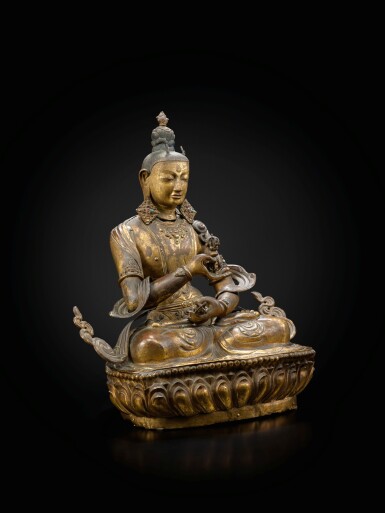
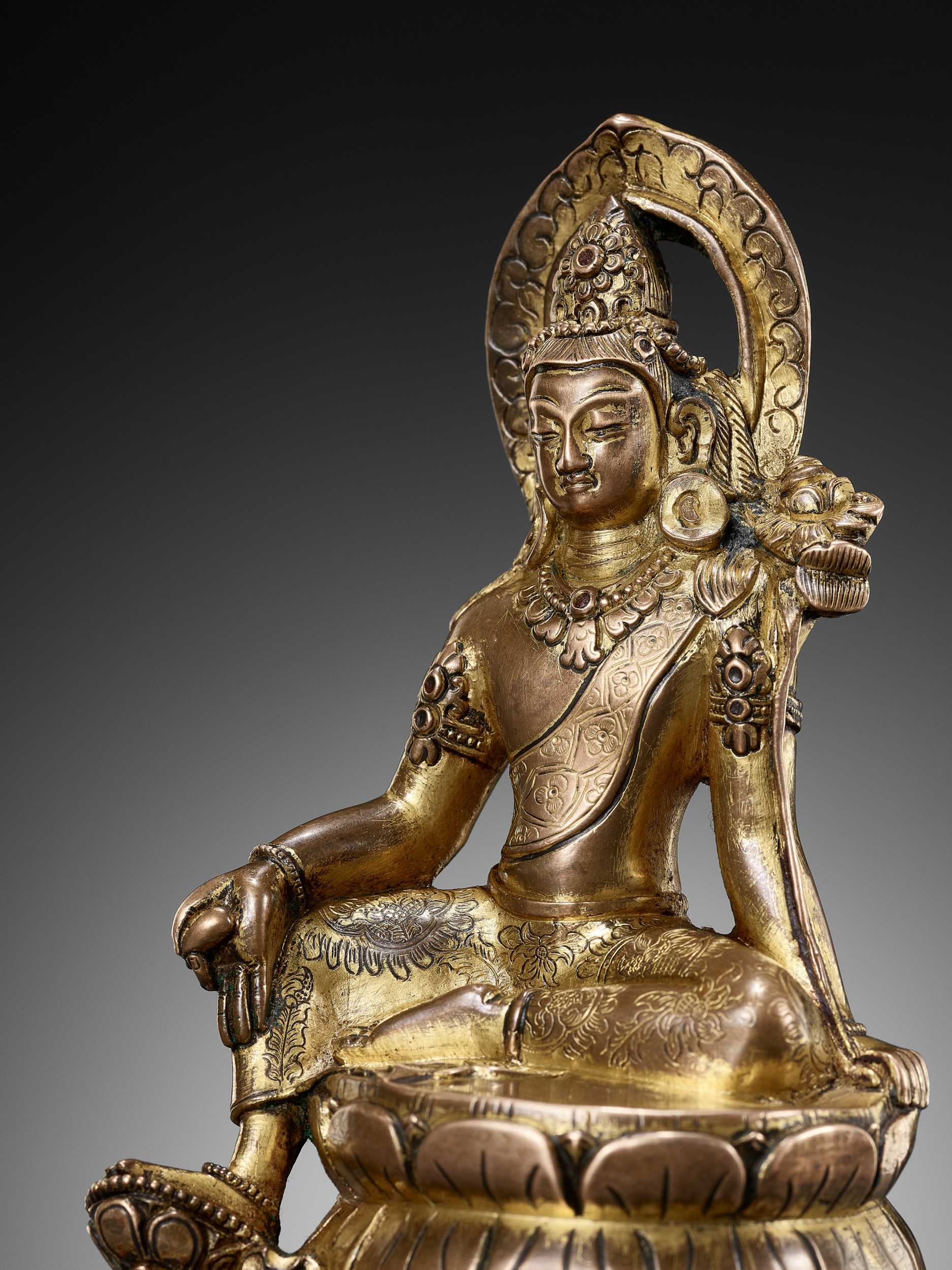
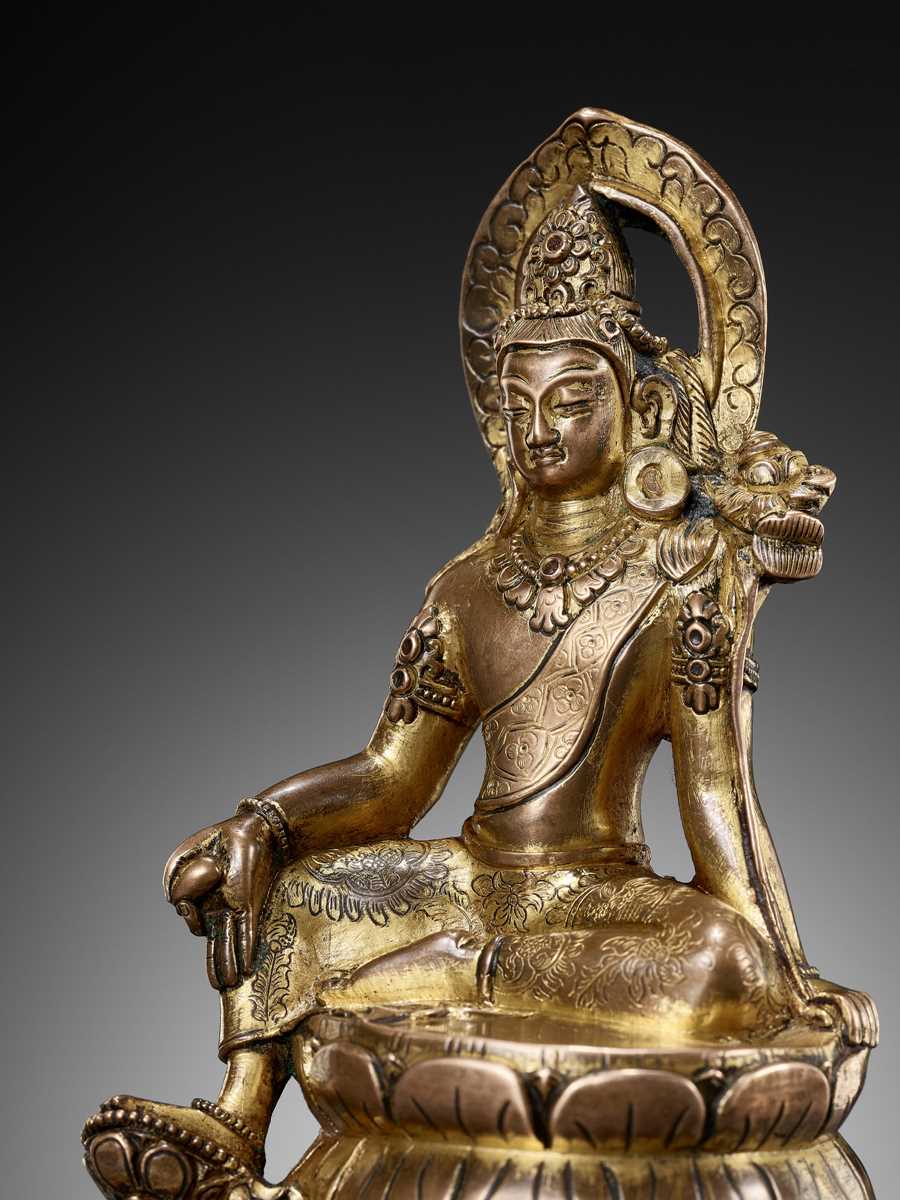

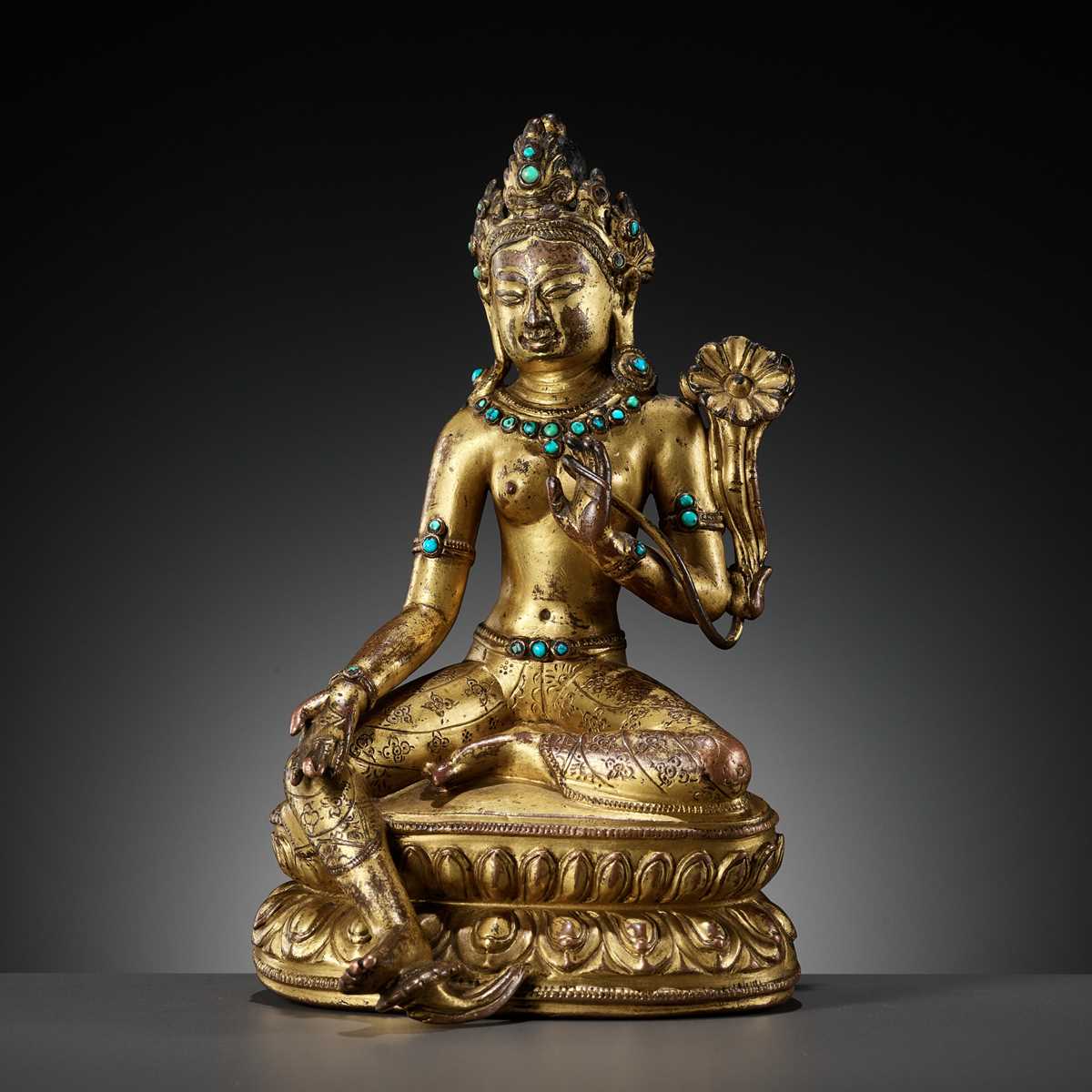
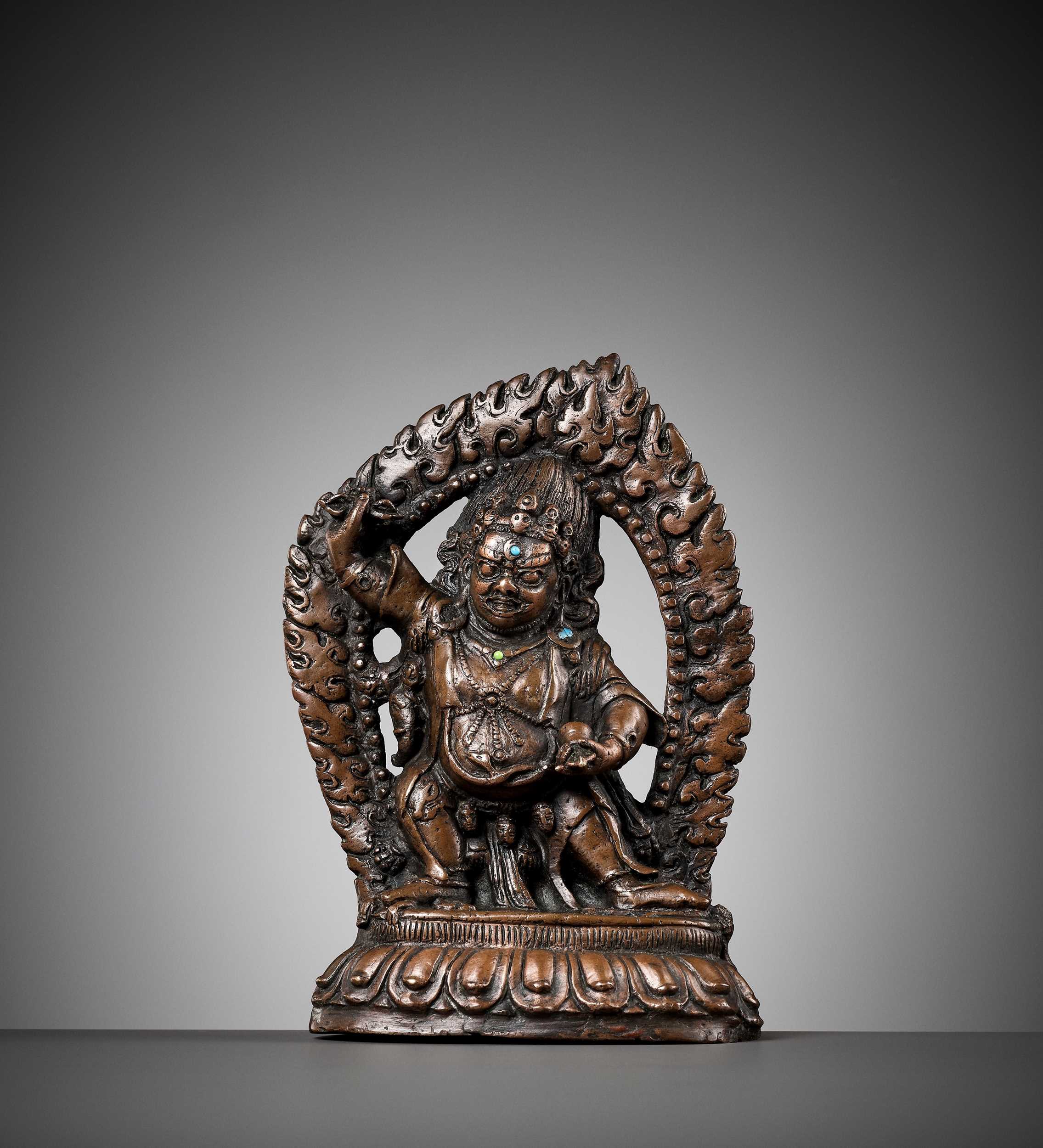
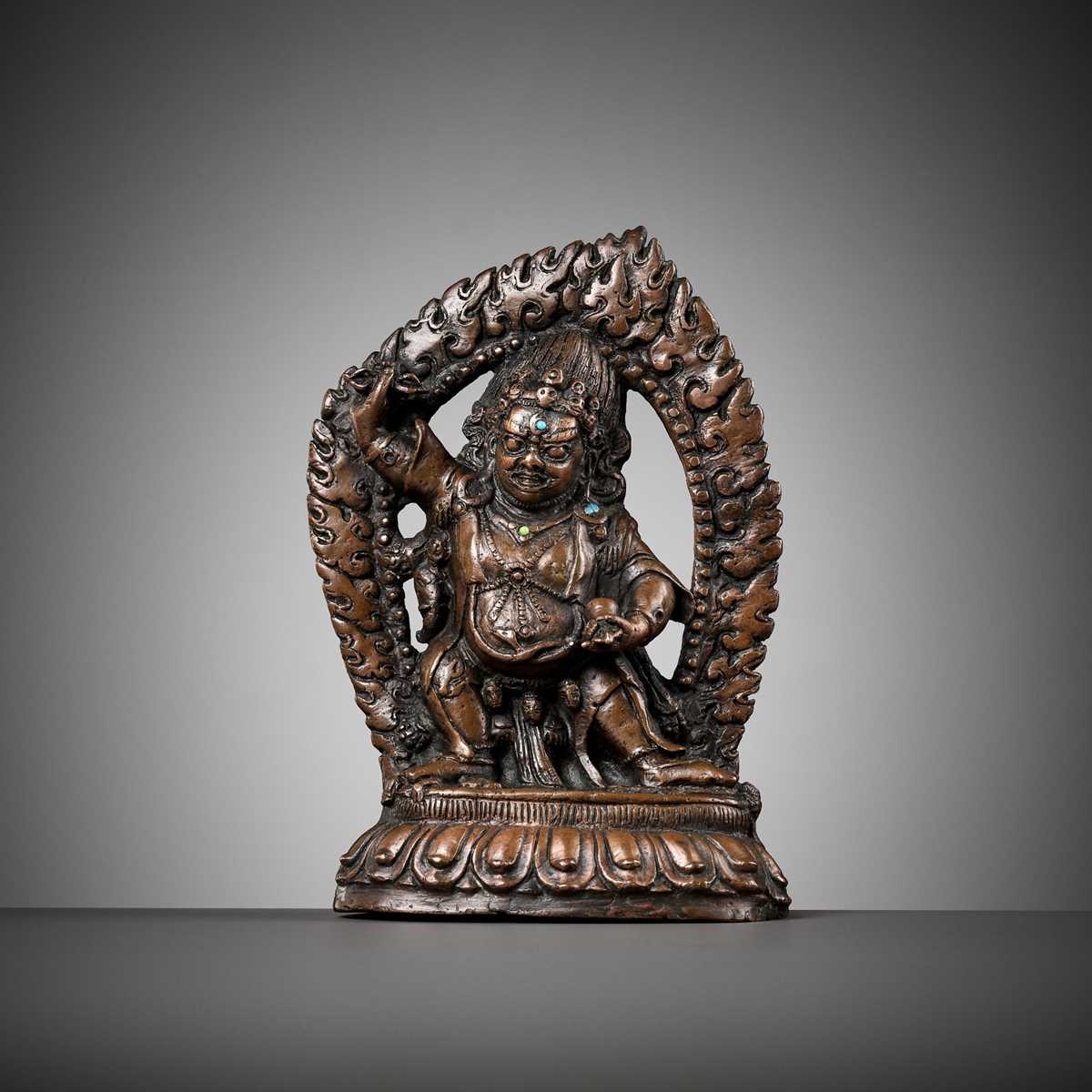

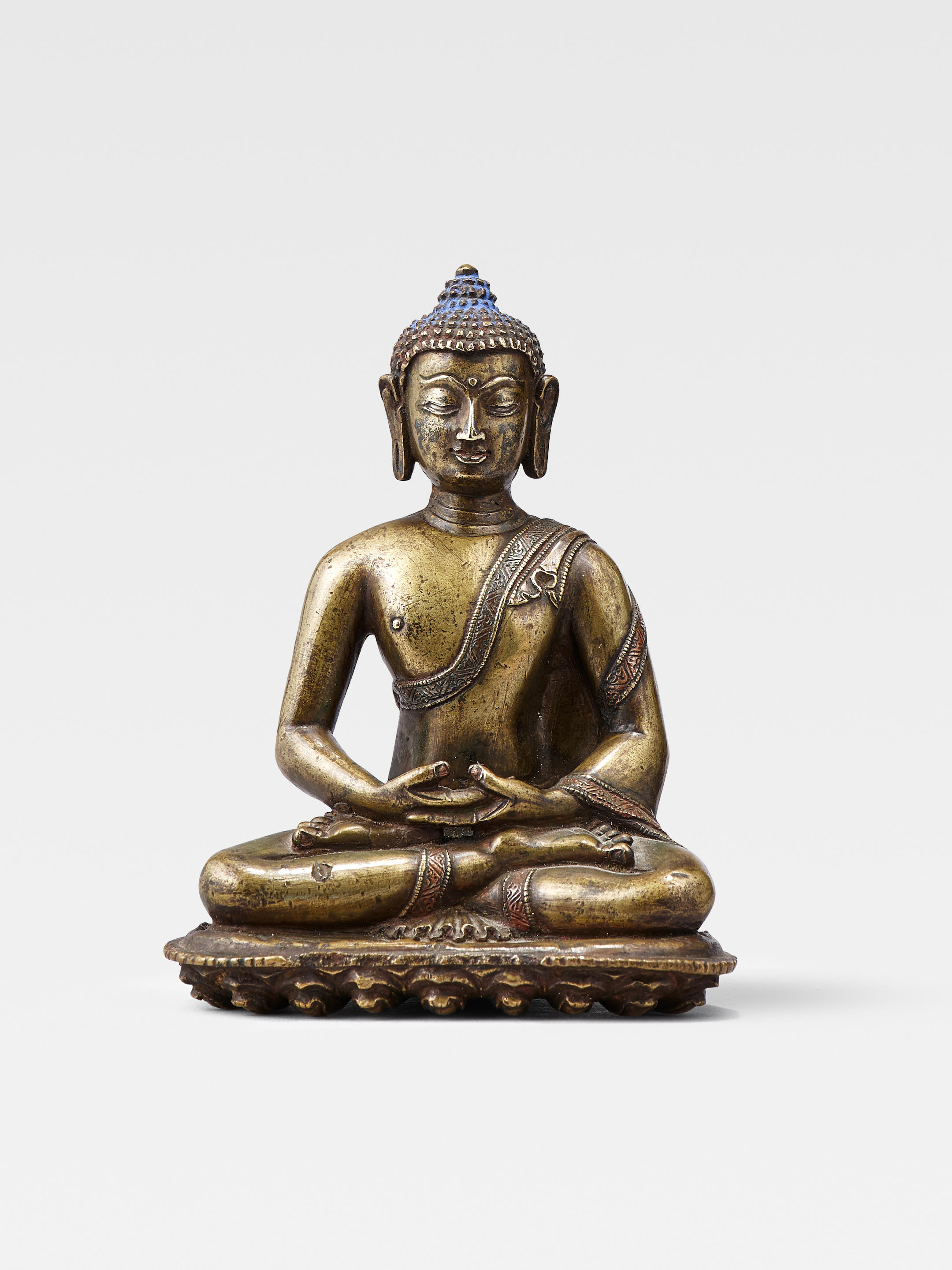



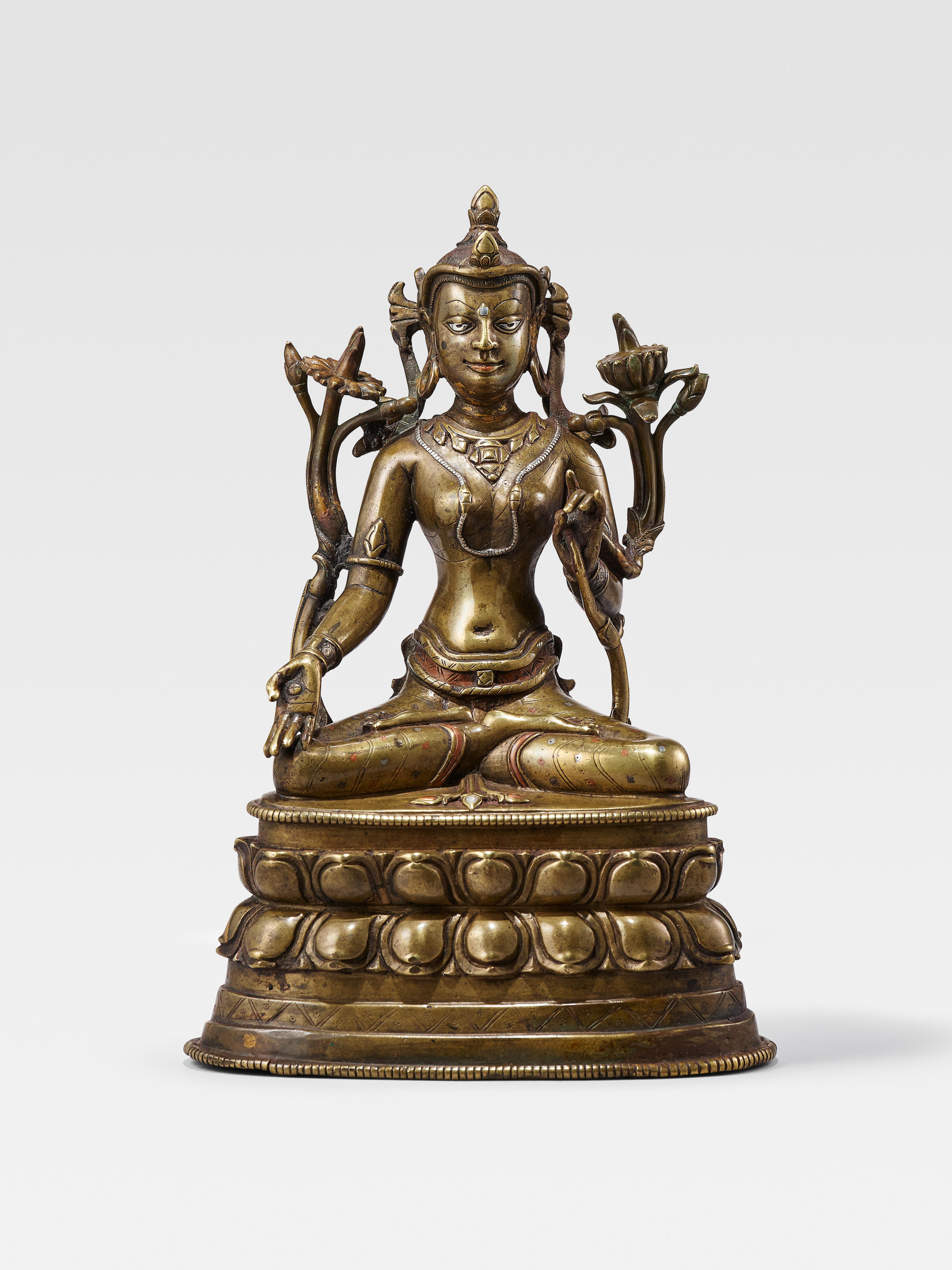
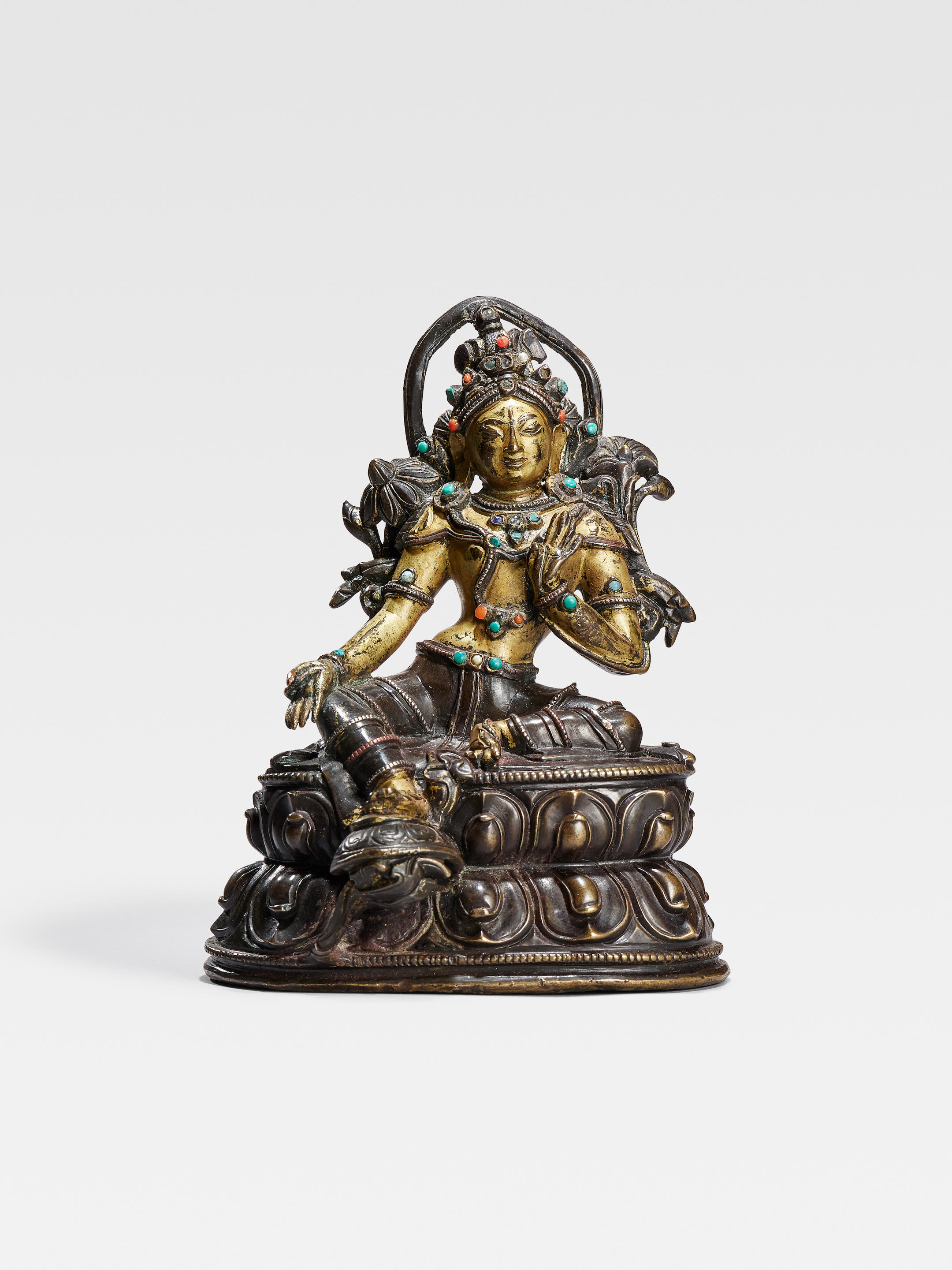
Try LotSearch and its premium features for 7 days - without any costs!
Be notified automatically about new items in upcoming auctions.
Create an alert